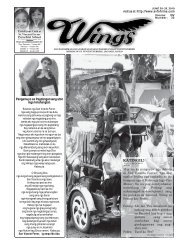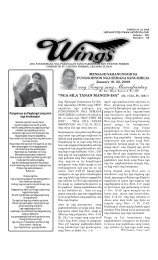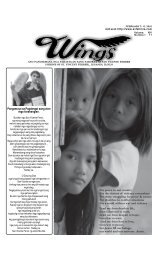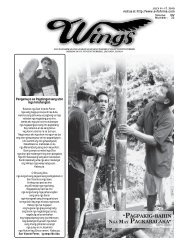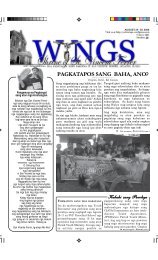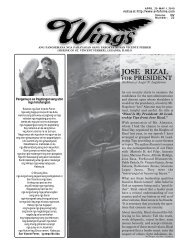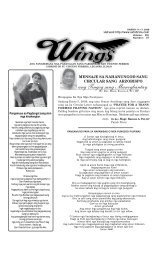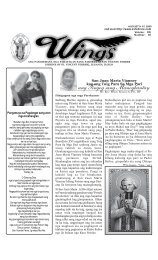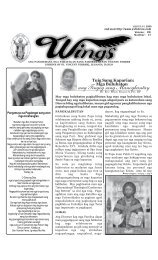Wings March 8- 14, 2009.pmd - Parokya ni San Vicente Ferrer ...
Wings March 8- 14, 2009.pmd - Parokya ni San Vicente Ferrer ...
Wings March 8- 14, 2009.pmd - Parokya ni San Vicente Ferrer ...
- No tags were found...
Create successful ePaper yourself
Turn your PDF publications into a flip-book with our unique Google optimized e-Paper software.
The Real ____________ Presence of GodReflectionsMay tatlo anay ka mangingisdanga nagpaindis-indis kon sa diinmay mas madamo nga isda. Silingsang taga-Masbate, “ Sa amon yapare, paghaboy mo sang bu<strong>ni</strong>t,waay 30 segundos alsa ka dasongapisikpisik ang isda.“Waay na pare,” sugpon sang taga-Negros, “sa amon ‘ya indi kanakinahanglan nga maghaboy pasang mo bu<strong>ni</strong>t, ituntun mu langsa tubig, hala sa dason gapisikpisikna ang isda.“Waay kamo sa amon pare,” sabatsang taga-Leganes, “ sa amon saLeganes antes mo ituntun ang imobu<strong>ni</strong>t sa tubig hawanan mo anaysang isda ang tubig agud maytuntunan ka sang imo bu<strong>ni</strong>t,”Daog nanaman ang taga-Leganes.Sin-o pa abi ang magdaog kay taga-Leganes man ang nagsugid si<strong>ni</strong>.Sa masami sugid sugid man langkita. Te, kon amo kita sina kaabilidadan ang masunod ngapamangkot amo ang: Te?,napaambit man bala naton i<strong>ni</strong>ngaton mga abilidad sa iban? Konmaayo gid man kita, nagmaayoman bala ang sitwasyon sang atonnga kaingod balay?Ang panahon sang Kwaresma,panahon sang pagpangmuyopagpuasa, kag pagpaambit. Ta<strong>ni</strong>imbes itikal naton,magpamalandong kita sa mgaginbuhat sang Dios sa aton -- sapagsakripisyo <strong>ni</strong> Jesus sa aton.Ta<strong>ni</strong>, magpuasa kita, indi lang sapag-sakrispisyo kundi paramakatipon kita sang substantialpara dako nga kantidad ang atonmahatag nga limos sa mga imolkag nagakinahanglan.The grace we ask for has to do with our twosenses of hearing and seeing. We pray todistinguish between the Word of God andprojecting our selfish desires into God’sWord. Hearing differs from liste<strong>ni</strong>ng andwe pray to allow the Word of God into thecenter of our lives where we can listen to itand to what that Word calls us.We are invited also to pray for seeing betterin Christ’s Light so to become familiarwith the path that leads to true life. Thelight for which we pray is not the same asclarity of course. Our readings for this liturgyand the spirituality of Lent call us toa faith and a liste<strong>ni</strong>ng which lead to ourtrusting God.The First Reading and the Gospel for thisSunday’s liturgy present us with two experiencesof liturgy, in a way. There is agoing up, a preparation or calling together,a central act of faith, a “Word of God”, asurprising revelation of the “real presenceof God, and a going onward.We hear first of the terrifying story ofAbraham’s being tested by God. He is calledto take his only son, Isaac, to a distant placeand sacrifice him by the k<strong>ni</strong>fe and thenbur<strong>ni</strong>ng him on an altar which Isaac wouldhelp build. Abraham takes his son whohelps carry the fire and the wood and offthey go in a journey of trust. Upon arrivalat a divinely-pointed-out hill, the dirtydeed is set in motion, no questions asked,except by Isaac who asks about the lamb tobe slain.At the point of the k<strong>ni</strong>fe’s being about toenter Isaac who has been bound and placedon the altar, the voice of the Lord’s messengercalls for a timeout. Abraham hasproven his faith so that he is not only thefather of Isaac still, but the “Father ofFaith” and the eternal model for the Peopleof God. A ram is tangled up in a near-bybush and so God has provided the meansfor the sacrifice rather than AbrahamA promise is then made by the Messengerof God that, through Abraham, as he continuesliving in faith, his descendants whowill increase through this same Isaac, willflourish and possess a land of blessing.The Gospel presents us with the “Transfiguration”.Peter, James and John go up ahill with Jesus. They have a most intimateencounter with Jesus, God the Beyond, andof course, themselves. Jesus dazzles His followerswith some state of glorification.Moses and Elijah are seen conversing withJesus. Moses is the “man of the Law” andElijah the “man of Prophesy”. Jesus is thefulfillment of the Law and the prophets andthe “voice” again ordains Him as “My belovedSon.” The terrified trio is encouragedalso to, “Listen to Him.”Immediately, there they are, just the fouragain and nobody else, no other sounds.They leave with this experience and theirquestions about what all this was about.Ipakita naton ang aton pagtuo! They are charged also not to speak aboutit until the “rising from the dead”, and4 Marso 8- <strong>14</strong>, 2009they did not understand this either, butthey kept on walking back down from thishill of intimacy.Most of us orient our lives, in varying degrees,toward and from the Eucharistic liturgy.We try also to be people who pray,what ever that means. Abraham and Isaachave an extreme close calling with God.Peter, James and John experience an unusualconvention and commu<strong>ni</strong>on. All fivego off into the regular, back-down-the-hillliving of their lives. Their faith seems to bestrengthened, but at the same time theirunderstanding seems to experience befuddlement.They would naturally be askingthemselves about the “realness” of whathad just happened.One of the great joys of human intimacy isthat it goes beyond reason. I enjoy askingcouples whom I have the privilege to be preparingfor marriage, “Why do you love her/him?” The relationships I trust the mostare those who fumble around for wordswhich might express some good reasons.Love is not reasonable. When there aremany verbal reasons, I suspect this is atransaction and not a transfiguration.Devotion, prayer, liturgy are such calls tosimple and honest closeness, that to try tofigure it out and explain it cheapens it andflattens it out into a practice rather than adelight.As with Abraham, Isaac, Peter, James andJohn, we go toward a time of being met bythe Holy, given something of ourselves bythe encouragement and comfort of God’spresence and then sent away, but alwaysthe little question, “Was that really real?”“Was I talking to myself, comforting myself,judging myself?” Intimacy does notlead to comprehending, but to the sending,the living, the transfiguring, or changing,because we are so loved.I love the Eucharist for so many reasons,but the very prime reason is that it defiesadequate intellectual explanation and I lovethat freedom from the factual, the scientific,the demand of my arrogant mind. TheEucharist is more than a transfiguration;it is a total trans from a something to aSomebody. The Somebody’s changing of theother somebodies who gather around theHoly Place is also unexplainable, but real.The closer we allow Jesus to come towardand within us, the more we, individuallyand communally, are transfigured and representedto the world. The world cannotadequately explain our living as His Newand Real Presence. We will never know ifour prayer was real. Abraham is our Fatherof Faith and our brothers of faithwalked down that hill with questions,doubts and wonderings about what inHeaven’s Name was all that about? Questionsdo not dampen faith, cheap answersdo. Living the faith is the proof of intimacy,just as living out married love intensifiesand proves the leap.“I will walk before the Lord, in the land ofthe living. I believed, even when I said, “Iam greatly afflicted.” - Psalm, 116



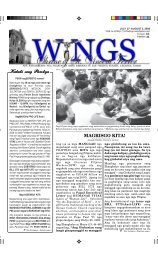
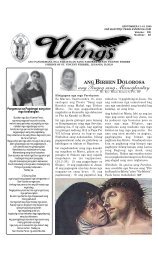
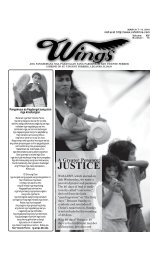
![1 - Parokya ni San Vicente Ferrer [Archdiocese of Jaro - Philippines]](https://img.yumpu.com/50295967/1/158x260/1-parokya-ni-san-vicente-ferrer-archdiocese-of-jaro-philippines.jpg?quality=85)
